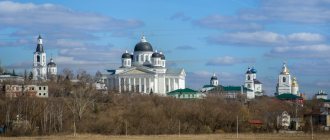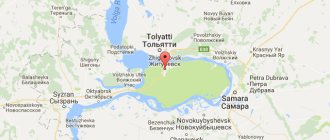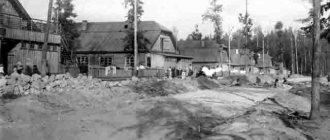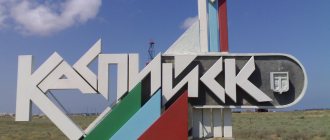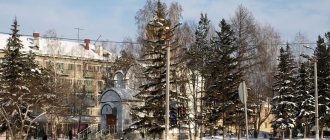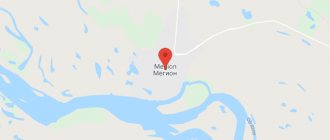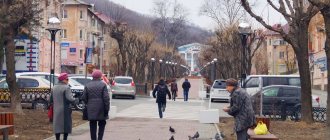Mariinsk is one of the oldest cities in Kuzbass. It is second in importance behind Novokuznetsk. You can find Mariinsk on the map of Russia on the Kiya River, 178 kilometers from Kemerovo, the capital of the region.
Its history is quite ancient. It was first mentioned in the seventeenth century. The emergence and development is associated with the Moscow-Siberian tract, and then with the discovery of placer gold deposits. In this regard, the population grew so quickly that in 1856 it acquired the status of a city and in honor of Empress Maria Alexandrovna it was renamed from Kiysk to Mariinsk in 1857.
At first, gold mining, agriculture, transportation, and trade developed here. By the beginning of the twentieth century, a number of small industrial enterprises had opened: brick factories, soap factories, tanneries, as well as one pottery factory and one brewery each. Now it is an agricultural area. The economy is represented by such sectors as:
- Liquor and vodka;
- Road construction;
- Railway.
You can get to know the city in absentia using a satellite map of Mariinsk.
Routes on the map of Mariinsk. Transport infrastructure
Mariinsk is a large railway junction (Dorozhnaya Street 1, in the city center) on the Trans-Siberian Railway. Belongs to the Krasnoyarsk Railway. The station is a junction station in terms of current flow in different directions, so locomotives change here, and passenger trains stop for 20-25 minutes. Electric trains also run from the station to Taiga. There is a locomotive depot and a luggage compartment.
The passage of the Federal Highway P255 “Siberia” and the highway P 400 from Tomsk allows for wide road connections between Mariinsk and different regions of Russia.
The presence of a bus station (next to the railway station), a convenient schedule of departure and arrival of intercity buses ensures constant and reliable communication with both settlements of the Kemerovo region and such large cities of Siberia as:
- Kemerovo;
- Novosibirsk;
- Tomsk;
- Krasnoyarsk
City public transport is represented by buses and minibuses that provide connections between city districts.
How much does it cost to go to Mariinsk
Let's calculate how much a trip to Mariinsk will cost. We will take into account everything: travel, accommodation, and food.
Food costs
Mariinsk is a small town, which makes it quite affordable to visit. It’s quite possible to get a set lunch for 300-400 rubles. Cozy cafes with homemade, high-quality food will not leave you hungry and at the same time will not empty your wallet.
How to get
Mariinsk has a railway and bus station. Based on this, you can get there in two ways.
- The closest major center to Mariinsk is the city of Kemerovo, located approximately one hundred and fifty kilometers from the museum city. The journey by car from Kemerovo to Mariinsk will take two hours, by bus – about three and a half. Ticket price is on average 350 rubles.
- And, of course, a passing train from Moscow: 3 trains go to Mariinsk - one of them is the famous Rossiya train from Moscow to Vladivostok. A one-way fare will cost approximately 4,500 rubles.
Costs for overnight stay
There are several hotels in Mariinsk, at varying distances from the center. The cost of a room ranges from 600-3500 rubles. As an option - an apartment for daily rent, the average cost per day is 1200 rubles.
Sights of the city of Mariinsk
The city has preserved its historical layout: stone and wooden buildings give an idea of the culture of the nineteenth century. There are more than a hundred historical and cultural monuments here. After visiting it, you can visit interesting places:
- St. Nicholas Church;
- Chapel of the Great Martyr Anastasia the Pattern Maker;
- Memorial to the victims of Siblag , dedicated to the repressed and exiled;
- House-museum of the famous Russian writer Viktor Chivilikhin , who was born in this city;
- Museum “Birch Bark of Siberia” , where you can admire various products made from birch bark: pieces, plates, boxes, boxes, chests, dolls, bast shoes, made by Siberian craftsmen;
- Mariinsky Museum of Local Lore , where historical materials, archaeological finds, and antiquities are collected;
- Bread Museum , which has a model of a Russian oven, wooden baking items, interesting material about the history of bread;
- Monument to Empress Maria Alexandrovna , located near the city library;
- Interesting monument to potatoes.
Mariinsk is one of the most notable places of Siberian exile
Mariinsk is one of the most notable places of Siberian exile
History was pleased to make Mariinsk one of the most noticeable places of Siberian exile - it is inscribed in the memory of the region with a special tragic line.
The first Mariinsky correctional labor institutions appeared in the mid-1920s with agricultural and industrial production. However, the heyday of the camp system occurred in the 30-40s of the 20th century. Mariinsk became the center of the Siberian OGPU camps. Many historians view Stalin's repressions as a continuation of the political repressions by the Bolsheviks in Soviet Russia, which began immediately after Siblag. The Siberian OGPU camps, organized in the early 30s, supplied forced labor to the Glavles enterprise, which exploited the forests of western and central Siberia. About two million prisoners. Mariinsk became the administrative center.
Complex "Memory"
On the territory of Western Siberia, the first SIBLON labor camp appeared in 1929 (SIBLON - “Siberian special purpose camps”). In 1935, SIBLON was renamed Siblag. In 1934, Siblag was included in the Gulag. (GULAG is the main directorate of forced labor camps, labor settlements, and places of detention - a division of the NKVD (Ministry of Internal Affairs) of the USSR, which manages the system of forced labor camps (ITL) in 1934-1960, the most important organ of the system of political repressions of the USSR).
At first, the lagovo administration was located in Novosibirsk, in 1933 it was transferred to Mariinsk, in 1935 back to Novosibirsk, in 1937 again to Mariinsk, in 1939 back to Novosibirsk. In 1943, the management of Siblag was finally transferred to Mariinsk. The camp's units are spread across the territory of what is now Novosibirsk, Kemerovo, Tomsk, Omsk regions, Krasnoyarsk and Altai territories. About 50 large Siblag camps of the 1930s have been established in Western Siberia.
Compositions of the complex
On April 7, 1942, the Siberian ITL NKVD was formed with its center in Mariinsk. It included the following departments: Arlyukskoye, Antibeskoye, Berikulskoye, Orlovo-Rozovskoye, Novo-Ivanovskoye, Suslovskoye, Yurginskoye and Mariinsky. Individual camp points: Mariysky, Baimsky, Kozhukhovsky. Almost SIBLAG existed in this composition until its disbandment in 1961.
In the ITL, three categories of prisoner detention regime were established: strict, enhanced and general. The strict regime included especially dangerous criminals convicted of banditry, armed robbery, premeditated murder, escapes from prison, and incorrigible recidivists. They were under enhanced security and supervision, could not be unescorted, were used primarily for hard physical work, and were subject to the most severe penalties for refusing to work for violations of the camp regime. “Political crimes” (Article 58 of the then code) were also considered especially dangerous.
Composition “Barracks for Prisoners”
Those convicted of robberies and other dangerous crimes, and repeat thieves were kept under an enhanced regime. These prisoners were also not subject to release and were used mainly for general work.
The rest of the prisoners in the correctional labor camp, as well as all those in correctional labor colonies (CPCs), were kept under general conditions. It was allowed to unconvoy them, use them in lower-level administrative and economic work in the apparatus of camp units and penal colonies, as well as involve them in the guard and convoy service for the protection of prisoners.
Historical information about SIBLAG
Number of camp units – 11
The names of the camp units are Antibesskoye, Arlyukskoye, Baimskoye, Izhmorskoye, Mariinskoye, Marpromotdeleniya, Novoivanovskoye, Orlovo - Rozovskoye, Suslovskoye, Yurginskoye branches and Kozhukhovsky OPL.
The number of camp contingents over the years of the camp’s existence is approximately 150-200 thousand people.
The ratio of political prisoners and criminal elements is 70% and 30%. The ratio of men and women is 45% and 55%. Types of regimes – general, strict, enhanced.
Composition “Execution Wall”
Types of production activities : crop production, livestock farming, processing of agricultural products. Production of industrial goods: cast iron, lumber, box containers, furniture, short fur coats, felt boots, hemp and jute production, clothing, bricks, peat extraction, capital construction. The main objects built by the camp prisoners are agricultural complexes. The mortality rate in the camp is -0.3 -0.9%.
On the territory of the Mariinsky district there was also an underground “execution” prison, where military leaders and clergy were kept. The exact number of deaths in this prison is still not known (according to unofficial data - over 40 thousand people).
On the territory of the former camps, settlements were formed that still exist today: the village of Orlovo - Rozovo, Chistopolye, Mikhailovka and others.
Chapel of Anastasia the Pattern Maker
The events of those years are a sad page in the history of our country and, in particular, of a small Siberian town. History cannot be forgotten, despite the fact that more than half a century has passed since those times. Sadly, a large number of truly great people visited Siblag. More than 200 thousand people passed through the Mariinsky camps. Among them are prominent military leaders, public figures, artists, writers, and poets.
Pyotr Dmitrievich Baranovsky - architect, restorer, scientist. The organizer of the museum in Kolomenskoye advocated the preservation of St. Basil's Cathedral in Moscow. Arrested in 1933, in Mariinsk he built an agricultural experimental station and other buildings according to his design.
Iosif Antonovich Mironchik, a participant in the storming of the Winter Palace in 1917, graduated from the Military Academy named after. Frunze. Arrested in 1937, sent to the labor camp. He worked in Mariinsk, was rehabilitated, and was awarded Government awards.
Johann Iosifovich Bauchnik, an Austrian, studied at the University of Vienna, his parents went to the Soviet Union. In 1941 he was arrested for “anti-Soviet agitation”; after his release he remained to live in Mariinsk, rehabilitated in 1965. He discovered archeological monuments in the Mariinsky district and taught English and German. Decency, responsiveness, competence are the characteristic character traits of this person.
Exhibition “Political Repressions”
Konstantin Konstantinovich Rokossovsky, Marshal of the Soviet Union, twice Hero of the Soviet Union. He ended up in Mariinsk during the years of great terror and was arrested in August 1937.
Natalia Ilyinichna Sats, People's Artist of the USSR, Hero of Socialist Labor, Laureate of the Lenin and State Prizes, the Lenin Komsomol Prize, professor of the Russian Academy of Theater Arts, talented director, teacher, author of plays and librettos for children's operas and ballets, creator of the world's first children's drama theater and the world's first musical theater for children. Arrested in 1937, she staged the play “Dowry” on the club stage of the Mariinsky Central Camp Department.
Dmitry Aleksandrovich Bystroletov, the son of Count Alexander Tolstoy, ended up in Czechoslovakia and became a foreign intelligence officer from 1925. Arrested in 1938, released in 1954, rehabilitated in 1956. He had the titles: Doctor of Law, Doctor of Medicine, member of the Union of Artists of the USSR, knew more than 20 languages.
This list can be continued for a very long time. There are no words that could express the desperate pain and deep compassion for the fate of these people. All that remains is memory and the ability to empathize. All that the modern generation can do in memory of the victims of Stalin’s genocide is to bow to the ground and erect a monument to them.
In the city of Mariinsk, such a monument appeared in August 2009, and not just a monument, but the Orthodox Memorial Complex “Memory”. The memorial was built in memory of the victims of the Siberian forced labor camp (Siblag, 1923-1960). On the territory of the complex, a chapel was erected in honor of the Great Martyr Anastasia the Pattern Maker - the heavenly patroness of all unjustly convicted, the comforter of prisoners.
Taking into account the tragic pages of history, regional and city authorities, together with the Kemerovo and Novokuznetsk diocese of the Russian Orthodox Church, decided to erect a chapel on the territory of Mariinsk, on the road along which prisoners were sent to the camps. And the name of Saint Anastasia is also associated with helping those unjustly convicted and consoling prisoners. (She was born in Rome at the end of the 3rd century into a rich and noble family. Secretly, in beggarly clothes, she visited dungeons where Christian prisoners languished, fed and watered the prisoners, healed them from illnesses, and supported their spirit. For her ascetic activities, Anastasia was subjected to cruel torture and torment, but did not change her faith.)
The consecrated chapel was built in just 10 months. A memorial to the victims of Siblag was erected next to it, which included compositions: narrow-gauge railway, meaning hard labor and hardships; a prison barrack as a symbol of the unsettled life of prisoners; “Hill of Memory” - as a conventional grave for all those who died during the years of repression and the “Execution Wall” with bullet holes and silhouettes of people as a symbol of the end of the road for many prisoners. A cedar-pine forest was planted on the territory of the complex in the fall - more than 1,200 seedlings in total.
The opening of the memorial was attended by members of the family of Archpriest Georgy Nepomnyashchikh, who was shot in Mariinsk in 1937 as a “clergyman,” who came from Bratsk and Moscow: these are the priest’s daughters Sofia Fedina and Zoya Ekenina and his grandchildren. The construction company and the Siberian Business Union holding company helped in the creation of the monument and chapel. The chapel project was developed by an architect from Novokuznetsk, Viktor Usoltsev.
Today, residents of Mariinsk and guests of the city can honor the memory of the victims of Siblag, bow to them and lay flowers. Newlyweds come here; all excursions for tourists, of whom there are many currently taking place in Mariinsk, begin with a visit to the Orthodox Memorial Complex “Memory”.
In addition, on October 30, on the Day of Remembrance of the Victims of Political Repression, the Mariinsk Local History Museum opened the exhibition “Political Repression of the 30-40-50s” and it is dedicated to people who were repressed, to those who did not have time to live and create their own on earth. the world, your home, your destiny. People who passed away as “enemies of the people”, persecuted by everyone, despised, forgotten and devoted to the Soviet anathema.
The exhibition's exposition consists of several sections: “Countrymen in Captivity”, “Repression on National Basis”, “Creative Siblag”, “Traces of Siblag. A separate stand is dedicated to Siblag employees.
The materials and photographs of the exhibition tell us that more than 200 thousand people passed through the Mariinsky camps. Information about truly great people is widely presented at the stands. The exhibition features a preserved fragment of a prison cell door with the inscription of the builders and a clock made by prisoners of the Krasno-Oryol branch of Siblag.
The opening of the exhibition “Political Repressions of the 30-40-50s” became possible due to the fact that the local history museum took part in the regional competition “Best Museum Institution of 2009”. The museum took 1st place in the “Best socio-cultural project of the year” category. In May, its director Viktor Petrovich Bondarenko was awarded a grant from the Governor of the Kemerovo Region in the amount of 50,000 rubles.
The material was provided by the Museum of Local Lore and the Museum-Reserve “Historical Mariinsk”.
Source: Department of Culture of the Mariinsky District of the Kemerovo Region
Main streets of Mariinsk
The main streets in the city are:
- Dorozhnaya street. Intersects with Lenin and Sergei Lazo streets. There is a city bus station on it;
- Lenin Street , intersecting with Rabochaya Street. On Lenin Street there is a city park of culture and recreation, a local history museum, and a large shopping center;
- 50 Let Oktyabrya Street intersects with Lenin, Kotovsky streets and a number of small streets. Here you can find a Gasoil gas station, and the Solnechny residential complex is also located on it;
- Palchikova Street is the longest highway in terms of length. It borders on Demchenko Street. The central city hospital is located here.
A map of Mariinsk with streets will allow you to get acquainted with other areas of the city. You can easily find the building you need on a map of Mariinsk with houses.
Mariinsk
(Kemerovo region)
OKATO code:
32422
Founded:
1698
City since:
1856 City of district subordination (Mariinsky district, Kemerovo region)
Center:
Mariinsky district
The city was formerly called:
| Kiyskoe | 1698 | 1857 |
| Telephone code (reference phone) | |
| 38443***** | 22-3-23 |
Deviation from Moscow time, hours:
4
Geographic latitude:
56°13′
Geographic longitude:
87°45′
Altitude above sea level, meters:
130 Sunrise and sunset times in the city of Mariinsk
Economy and industry of Mariinsk
Mariinsk is a small city, so it does not have large economic infrastructure. Previously there were:
- Meat processing plant;
- Timber processing plant;
- Sewing and knitting factories;
- Metal products plant;
- Furniture factory.
Now there is only:
- Alcohol plant;
- Distillery;
- Bakery;
- Road repair and construction department.
Rural tourism, small and medium-sized businesses, and trade are developing.
